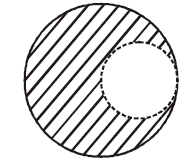Embibe Experts Solutions for Chapter: Gravitation, Exercise 3: Exercise - 3
Embibe Experts Physics Solutions for Exercise - Embibe Experts Solutions for Chapter: Gravitation, Exercise 3: Exercise - 3
Attempt the free practice questions on Chapter 11: Gravitation, Exercise 3: Exercise - 3 with hints and solutions to strengthen your understanding. Alpha Question Bank for Engineering: Physics solutions are prepared by Experienced Embibe Experts.
Questions from Embibe Experts Solutions for Chapter: Gravitation, Exercise 3: Exercise - 3 with Hints & Solutions
Two particles of equal mass go around a circle of radius under the action of their mutual gravitational attraction. The speed of each particle with respect to their centre of mass is:
The mass of a spaceship is It is to be launched from the earth's surface out into free space. The value of and (radius of earth) are and , respectively. The required energy for this work will be:
What is the minimum energy required to launch a satellite of mass from the surface of a planet of mass and radius in a circular orbit at an altitude of ?
Four particles, each of mass on vertices of a square move along a circle of radius under the action of their mutual gravitational attraction. The speed of each particle is:
From a solid sphere of mass and radius , a spherical portion of radius is removed as shown in the figure. Taking gravitational potential the potential at the centre of the cavity thus formed is: ( gravitational constant)

A satellite is revolving in a circular orbit at a height from the earth’s surface (radius or earth ; ). The minimum increase in its orbital velocity required, so that the satellite could escape from the earth’s gravitational field is close to: (Neglect the effect of atmosphere)
The variation of acceleration due to gravity with distance d from centre of the earth is best represented by ( Earth's radius)
A particle is moving in a circular path of radius , under the action of an attractive potential, . Its total energy is
